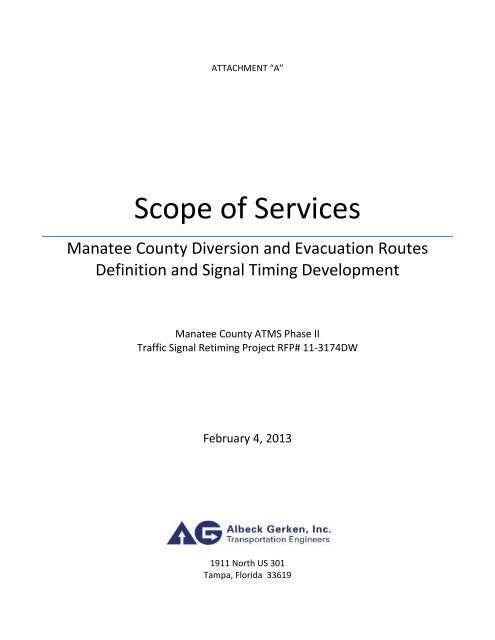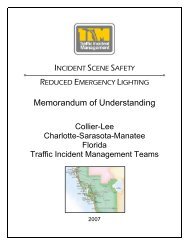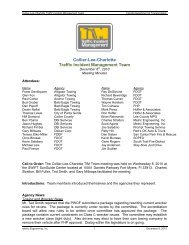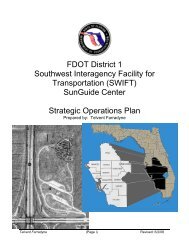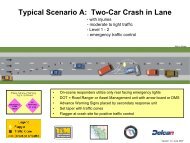SITUP Scope of Services - Traffic Incident Management
SITUP Scope of Services - Traffic Incident Management
SITUP Scope of Services - Traffic Incident Management
You also want an ePaper? Increase the reach of your titles
YUMPU automatically turns print PDFs into web optimized ePapers that Google loves.
ATTACHMENT “A”<strong>Scope</strong> <strong>of</strong> <strong>Services</strong>Manatee County Diversion and Evacuation RoutesDefinition and Signal Timing DevelopmentManatee County ATMS Phase II<strong>Traffic</strong> Signal Retiming Project RFP# 11-3174DWFebruary 4, 20131911 North US 301Tampa, Florida 33619
<strong>Scope</strong> <strong>of</strong> <strong>Services</strong>Manatee County Diversion and Evacuation RoutesDefinition and Signal Timing DevelopmentOVERVIEWThe purpose <strong>of</strong> this exhibit is to describe the scope <strong>of</strong> work and responsibilities <strong>of</strong> Albeck Gerken, Inc.,Manatee County, and the Florida Department <strong>of</strong> Transportation, District One, for the conduct and successfulcompletion <strong>of</strong> the Manatee County Diversion and Evacuation Routes Definition and Signal Timing Developmentproject assignment.This assignment addresses multiple scenarios that impact arterial roadways within Manatee County:- The closure (mono-directional or bi-directional) <strong>of</strong> a segment <strong>of</strong> Interstate 75 due to an incident,requiring the diversion <strong>of</strong> mainline traffic onto the surface street arterial network. Multiple segmentsfall within the Manatee County jurisdiction.- The closure (mono-directional or bi-directional) <strong>of</strong> either <strong>of</strong> the US 41 Business or US 301 bridgesacross the Manatee River due to an incident, requiring the diversion <strong>of</strong> traffic to the alternate bridge.- The issuance <strong>of</strong> an evacuation order for the barrier islands <strong>of</strong> Manatee County, resulting in the use <strong>of</strong>State Routes 64 (Manatee Avenue) and 684 (Cortez Road) as highly directional evacuation routes.It is generally understood that the surface street arterial network will not provide the capacity necessary toaccommodate the traffic volumes anticipated during these scenarios without significant vehicular delay andcongestion. The objective <strong>of</strong> this assignment is to develop a strategic plan for addressing these scenarios bymaximizing the throughput <strong>of</strong> the diversion or evacuation route through traffic engineering and trafficoperations practices. This includes:- The development and implementation <strong>of</strong> traffic signal timing patterns that can be deployed via theCounty’s ATMS.now advanced traffic management system. These patterns would be configured tomaximize the throughput <strong>of</strong> the diversion route’s predominant direction <strong>of</strong> travel.- The identification <strong>of</strong> traffic engineering improvements that would improve the flow <strong>of</strong> traffic throughthe diversion route, including, but not limited to, signing improvements, phasing changes, laneconfiguration changes, and minor geometric changes. Concepts for each route would be identifiedwith sufficient detail for subsequent projects to be developed for implementation.- The identification <strong>of</strong> locations where law enforcement could effectively be deployed to maintain trafficflow where the severest congestion is anticipated.- The development <strong>of</strong> a decision matrix and operations guide, for use by agency personnel when asubject incident occurs, to provide readily accessible information on the deployment <strong>of</strong> thecountermeasures.The implementation <strong>of</strong> diversion and evacuation routes and the deployment <strong>of</strong> associated resources willrequire the coordination with and buy-in <strong>of</strong> multiple agencies across several jurisdictions. This coordinationwould undoubtedly involve the Florida Highway Patrol, the Manatee County Sheriff’s Department, the FloridaDepartment <strong>of</strong> Transportation’s <strong>Traffic</strong> Operations, Maintenance, and Emergency <strong>Management</strong> groups, theCity <strong>of</strong> Bradenton’s Public Works and Police Departments, Manatee County Public Works and <strong>Traffic</strong>2
<strong>Scope</strong> <strong>of</strong> <strong>Services</strong>Manatee County Diversion and Evacuation RoutesDefinition and Signal Timing DevelopmentEngineering, and Manatee County Emergency <strong>Management</strong>. This assignment will be closely coordinated withthose agencies as stakeholders, with primary access through the local <strong>Traffic</strong> <strong>Incident</strong> <strong>Management</strong> Team (TIMTeam).The following steps provide a framework for project execution, timelines and deliverables.TASK 1: PROJECT MANAGEMENT, COORDINATION, AND MEETINGSTask 1 includes all project activities related to project management, coordination between stakeholders, andthe scheduling, agenda preparation, conduct, and documentation <strong>of</strong> project meetings.a) Kick<strong>of</strong>f meeting - Albeck Gerken, Inc., Manatee County, and the Florida Department <strong>of</strong> TransportationDistrict One (FDOT-D1) will initiate the project at a kick<strong>of</strong>f meeting. In addition to discussingadministrative issues, the kick<strong>of</strong>f meeting will be a working technical meeting. Key outcomes from thekick<strong>of</strong>f meeting will be: Discussion <strong>of</strong> project goals, how the project came about and any specific definitions <strong>of</strong> projectsuccess. Identify any project constraints, restraints or special conditions. Determine whatconstitutes success <strong>of</strong> the project. Discussion <strong>of</strong> Interstate 75 diversion routes as defined in the Manatee County I-75 CorridorTrailblazer Project Draft Concept <strong>of</strong> Operations 1 , with information on past incidents and how theywere addressed. Discussion <strong>of</strong> Manatee River Bridge diversions, with information on past incidents and how theywere addressed. Discussion <strong>of</strong> hurricane evacuation plans and routes, with information on how they wereaddressed in the past. Discussion <strong>of</strong> administrative issues such as invoicing procedures, number <strong>of</strong> reports required,report format, any administrative routing procedures, etc. Development <strong>of</strong> the Project Schedule to include additional meetings, key delivery dates, anyimpacts to operations, and any other issues associated to schedule.Deliverables: Project schedule Meeting minutes following the meeting.b) <strong>Traffic</strong> <strong>Incident</strong> <strong>Management</strong> Team Meeting #1 – Albeck Gerken, Inc., will present an overview <strong>of</strong> theproject at a <strong>Traffic</strong> <strong>Incident</strong> <strong>Management</strong> (TIM) Team meeting 2 . This meeting will include a discussion<strong>of</strong> a qualitative analysis <strong>of</strong> the Interstate 75 diversion routes as defined in the Draft Concept <strong>of</strong>Operations, the River Bridge diversion routes, the hurricane evacuation routes, the strategies and toolsneeded to implement such diversions, and the resources needed from participating agencies forvarious levels <strong>of</strong> implementation. Feedback received at this presentation will provide the basis for thedevelopment <strong>of</strong> the draft design <strong>of</strong> the routes.1 Manatee County I-75 Corridor Trailblazer Project, Draft Concept <strong>of</strong> Operations, Version 1.0, September 28, 2010.Prepared for FDOT District One’s Intelligent Transportation Systems Section by Metric Engineering.2 A current roster <strong>of</strong> the Team is included as an attachment to this <strong>Scope</strong>.3
<strong>Scope</strong> <strong>of</strong> <strong>Services</strong>Manatee County Diversion and Evacuation RoutesDefinition and Signal Timing DevelopmentTechnical Memorandum 1, an overview <strong>of</strong> the project and a quantitative discussion <strong>of</strong> route suitability,would be submitted in advance <strong>of</strong> this meeting.c) <strong>Traffic</strong> <strong>Incident</strong> <strong>Management</strong> Team Meeting #2 – Albeck Gerken, Inc., will present the draft designs <strong>of</strong>the various diversion scenarios, including recommendations related to intersection operations(signalization, signing, temporary lane configuration, law enforcement presence, etc.), corridoroperations (timing patterns, signing), and other design concepts, with the intention <strong>of</strong> obtainingconcurrence to advance to the development <strong>of</strong> diversion signal timing patterns.Technical Memorandum 2, the recommended strategies and draft designs for various diversionscenarios, would be submitted in advance <strong>of</strong> this meeting.d) Project Review Meeting - Albeck Gerken, Inc., Manatee County, and FDOT-D1 will meet to reviewproposed timing patterns for the diversion routes. The objective <strong>of</strong> this meeting is to obtainconcurrence on the timing patterns and approval to initiate implementation in the field.Technical Memorandum 3, the proposed timing patterns for diversion routes, would be submitted inadvance <strong>of</strong> this meeting. Minutes <strong>of</strong> the meeting will be developed.e) <strong>Traffic</strong> <strong>Incident</strong> <strong>Management</strong> Team Meeting # 3 –The project team will present the proposed plan tothe TIM Team. An Implementation guide, showing each route, the proposed deployment <strong>of</strong> signs andresources, and decision tree for the determination <strong>of</strong> the appropriate strategies, would be submittedin advance <strong>of</strong> this meeting.f) Project Closure Meeting - Albeck Gerken, Inc., Manatee County, and FDOT-D1 will meet to review thefinal report for the project. Minutes <strong>of</strong> the meeting will be developed.The Draft Final Report will be submitted in advance <strong>of</strong> this meeting. Based on comments received atthe Project Closure meeting, a Final Report will be developed and distributed to the projectparticipants.TASK 2: ESTABLISH INTERSTATE AND RIVER BRIDGE DIVERSION ROUTE AND ARTERIAL EVACUATIONROUTE SCENARIOS AND CRITERIAThis task will establish the routes to be utilized for the various diversion and evacuation scenarios.a) Review the routes and strategies included within the Interstate 75 Trailblazer project Draft Concept <strong>of</strong>Operations from a qualitative traffic engineering standpoint, to determine if there are majorbottlenecks, restrictions, or other impediments to implementation that would suggest the need for analternate route. Include a discussion <strong>of</strong> assumptions <strong>of</strong> traffic volumes that might be diverted duringdifferent scenarios, the current traffic volumes along the diversion routes, and the relativeopportunities for success.4
<strong>Scope</strong> <strong>of</strong> <strong>Services</strong>Manatee County Diversion and Evacuation RoutesDefinition and Signal Timing Developmentb) Develop proposed strategies for diversion routes for the two Manatee River bridge crossings (BusinessUS 41 and US 301) based on a qualitative traffic engineering review, considering any majorbottlenecks, restrictions, or other impediments to implementation that would suggest the need for analternate route. Include a discussion <strong>of</strong> assumptions <strong>of</strong> traffic volumes that might be diverted duringdifferent scenarios, the current traffic volumes along the diversion routes, and the relativeopportunities for success.c) Identify the current hurricane evacuation route plans, as developed by Manatee County Emergency<strong>Management</strong>, and develop proposed strategies that would enhance the capacity <strong>of</strong> the evacuationroutes. Include a discussion <strong>of</strong> the traffic volumes that might be encountered during such an event,the current traffic volumes along the evacuation routes, and the relative opportunities for success.d) Develop a technical memorandum that summarizes Task 2 activities, providing an overview <strong>of</strong> theproject and quantitative discussion <strong>of</strong> route suitability. This would be the primary discussiondocument for the <strong>Traffic</strong> <strong>Management</strong> Team meeting #1.Deliverable: Technical Memorandum 1 – Overview <strong>of</strong> project and quantitative discussion <strong>of</strong> routesuitability. Ten (10) copies will be provided.TASK 3: DEVELOP CONCEPTUAL STRATEGIES FOR DIVERSION / EVACUATION ROUTE IMPLEMENTATIONTask 3 develops the conceptual strategies for the implementation <strong>of</strong> the various scenarios, and includes thefollowing elements:a) Develop draft designs <strong>of</strong> the various diversion scenarios, including recommendations related tointersection operations (signalization, signing, temporary lane configuration, law enforcementpresence, etc.), corridor operations (timing patterns, signing), and other design concepts.b) Develop appropriate GIS mapping <strong>of</strong> impacted signalized intersections, by scenario.c) Develop a series <strong>of</strong> Synchro models for the affected corridors based on Phase I & II signal timing workproducts.d) Develop a technical memorandum that summarizes Task 3 activities, providing a discussion <strong>of</strong> theproposed implementation scenarios and the various elements therein. This would be the primarydiscussion document for the <strong>Traffic</strong> <strong>Management</strong> Team meeting #2.Deliverable: Technical Memorandum 2 – Recommended strategies and draft designs for various diversionscenarios. Ten (10) copies will be provided.5
<strong>Scope</strong> <strong>of</strong> <strong>Services</strong>Manatee County Diversion and Evacuation RoutesDefinition and Signal Timing DevelopmentTASK 4: DEVELOP TIMING PATTERNS FOR DIVERSION / EVACUATION ROUTESTask 4 develops the timing patterns to be implemented along the Diversion and Evacuation routes.a) Based upon the efforts <strong>of</strong> Tasks 2 and 3, develop signal timing patterns for the various diversionand evacuation scenarios.1. Determine affected intersections and flex groups for each scenario, establishing additionalflex groups as needed2. Estimate diversion scenario volumes based on capacities <strong>of</strong> evacuation route3. Design diversion route timing plans using Synchro & Tru-<strong>Traffic</strong>. The objective <strong>of</strong> thetiming patterns will be to maximize the throughput along the corridor in the predominantdirection <strong>of</strong> travel for the diversion or evacuation scenario being evaluated. Cycle lengthswill be maximized to minimize the disruptions to the predominant travel flow; side streetsand minor movements will be serviced as necessary to provide reasonable cross access,but significant delays on the non-predominant approaches will occur. Offsets will be set toallow for progression in the predominant direction.b) A report documenting the proposed draft timing patterns will be developed and submitted toManatee County and FDOT-D1 for review. This report will be prepared in the standard FDOTDistrict One specified timing report format. All Synchro files, Tru-<strong>Traffic</strong> files, and Excelspreadsheet files <strong>of</strong> the timing sheets will be included on a CD-ROM as part <strong>of</strong> the deliverables.Deliverable: Technical Memorandum 3 - Draft timing pattern report. Four (4) copies will be provided.TASK 5: FINALIZE AND IMPLEMENT TIMING PATTERNS FOR DIVERSION / EVACUATION ROUTESTask 5 finalizes the timing patterns for the Diversion and Evacuation routes and implements the patterns onthe ATMS.now system.a) Based upon comments received in the review <strong>of</strong> Technical Memorandum 3, the timing patternswill be updated and finalized and submitted in a signed and sealed report with updated files on aCD-ROM.b) Albeck Gerken, Inc. will download the new patterns via ATMS.now. Albeck Gerken, Inc. staff canperform all implementation tasks without required participation from the Manatee County;however we realize the County will likely be involved at least initially. Albeck Gerken, Inc. willplace an ATMS operator in the client’s <strong>Traffic</strong> <strong>Management</strong> Center as needed to monitor thecentral s<strong>of</strong>tware as well as being in contact with the field crew.c) Once downloaded, Albeck Gerken, Inc. staff will review the operation <strong>of</strong> each intersection andpattern without exception. The goal <strong>of</strong> this step is to ensure the timing plans have beenimplemented as designed and no system configuration errors have occurred that would preclude asmooth fine-tuning process. This will be conducted during the overnight hours to minimizedisruption to traffic on the street.6
<strong>Scope</strong> <strong>of</strong> <strong>Services</strong>Manatee County Diversion and Evacuation RoutesDefinition and Signal Timing Developmentd) Albeck Gerken, Inc. field implementation team will review the pattern timing by driving thecorridor under study and by using the Tru-<strong>Traffic</strong> display features. Fine-tuning will generallyconsist <strong>of</strong> <strong>of</strong>fset and split changes. This would occur during the overnight hours to minimizedisruption to traffic flow. Albeck Gerken, Inc. and the County (and FDOT District One, where signalson state roads are involved) will agree as to final acceptance prior to closing out implementationefforts. This would typically involve a check ride <strong>of</strong> the corridor to ensure performanceimprovements are in line with project goals.Deliverable: Signed and sealed final timing report. Two (2) copies will be provided. Implemented and field verified timing patterns.TASK 6: DEVELOP IMPLEMENTATION GUIDETask 6 is the development <strong>of</strong> an easy to use Implementation Guide intended to be utilized as a referenceduring incident conditions and the deployment <strong>of</strong> a diversion route. It will include a decision tree matrix toselect when to implement - and de-implement – diversion routes based on the nature <strong>of</strong> the incident beingaddressed. It will also include recommended deployment locations for signs, channelizing devices, lawenforcement personnel, and other strategies related with each scenario.This Implementation Guide would be the basis for the third and final meeting with the <strong>Traffic</strong> <strong>Incident</strong><strong>Management</strong> Team. The draft <strong>of</strong> the Guide would be distributed to the <strong>Traffic</strong> <strong>Incident</strong> <strong>Management</strong> Teammembers at least two weeks in advance <strong>of</strong> the meeting for review. The meeting discussion will go through theroles <strong>of</strong> all involved, with the goal <strong>of</strong> achieving concurrence from all agencies. If necessary to achieve thisconcurrence, changes and modifications to the Guide will be discussed and agreed upon at the meeting. Basedon comments from the meeting, a finalized Guide will be developed.Deliverable: Draft Implementation Guide. Twenty (20) copies will be provided. Final Implementation Guide. Twenty (20) copies and an electronic (PDF format) copy will beprovided.TASK 7: DEVELOP FINAL REPORTTask 7 is the development <strong>of</strong> a Final Report documenting the project. It is envisioned that the final report willbe based heavily on the previously submitted and reviewed Technical Memoranda and project submittals,assembled into a single easy to access project document.A draft <strong>of</strong> the Final Report will be submitted to the County and FDOT-D1 for review; after comments arereceived, a signed and sealed Final Report will be submitted.Deliverable: Final Report. Four (4) copies will be provided.7
<strong>Scope</strong> <strong>of</strong> <strong>Services</strong>Manatee County Diversion and Evacuation RoutesDefinition and Signal Timing DevelopmentCOUNTY AND FDOT-D1 RESPONSIBILITIESIn order to ensure the appropriate input into the project, as well as to maintain project schedules, it is criticalfor Manatee County and FDOT-D1 to review submittals in a timely manner. It is requested that all reviews <strong>of</strong>technical memoranda and other report submissions be completed within three weeks <strong>of</strong> receipt.PROJECT SCHEDULEThe anticipated duration <strong>of</strong> this project is approximately 280 days from the Notice to Proceed. As meetingswith the <strong>Traffic</strong> <strong>Incident</strong> <strong>Management</strong> Team are a key element <strong>of</strong> this project, it may be necessary to adjustthis duration to reflect their meeting schedule. A detailed schedule will be included at the kick-<strong>of</strong>f meeting fordiscussion.8
<strong>Scope</strong> <strong>of</strong> <strong>Services</strong>Manatee County Diversion and Evacuation RoutesDefinition and Signal Timing DevelopmentRoster – Sarasota/Manatee <strong>Traffic</strong> <strong>Incident</strong> <strong>Management</strong> Team511 Tampa Bay / <strong>Traffic</strong>.ComAAAAlligator TowingAmerican Compliance TechnologiesAnchor TowingBradenton Fire DepartmentBradenton Police DepartmentCedar Hammock Fire RescueCenter for Urban Transportation Research (CUTR)-USFCity <strong>of</strong> North PortCity <strong>of</strong> SarasotaCity <strong>of</strong> Sarasota Public WorksCity <strong>of</strong> Venice FireClear Channel RadioCoastland Auto Road Rangers, Inc.DBI <strong>Services</strong>Delcan CorpDirect TowingDuette Fire and Rescue DistrictEast Manatee Fire RescueELVIS TowingFDOT-SWIFT SunGuide CenterFederal Highway AdministrationFlagship TowingFlorida Department <strong>of</strong> Environmental ProtectionFlorida Department <strong>of</strong> TransportationFlorida Highway PatrolFlorida Independent Towing & Recovery Assoc.Highway Technology (Formerly United Rentals)HNTB CorpH<strong>of</strong>fer & AssociatesHolmes Beach Police DepartmentJohnsons TowingKimley-Horn & Associates, Inc.Longboat Key, Town <strong>of</strong>Manatee County Emergency Medical <strong>Services</strong>Manatee County Public Works9
<strong>Scope</strong> <strong>of</strong> <strong>Services</strong>Manatee County Diversion and Evacuation RoutesDefinition and Signal Timing DevelopmentRoster – Sarasota/Manatee <strong>Traffic</strong> <strong>Incident</strong> <strong>Management</strong> Team (continued)Manatee County Transportation DepartmentMedia Relations GroupMetric Engineering, Inc.Metro Networks/Westwood OneMiller Industries & TowingMyakka City Fire DistrictNokomis Fire DepartmentNorth Point Fire RescueNorth Port Fire Rescue DistrictNorth Port Police DepartmentNorth River Fire DistrictParrish Fire DistrictPrompt TowingPublic Works Department- City <strong>of</strong> North PortRoad Rangers – District OneSarasota CountySarasota County Fire DepartmentSarasota County Sheriff's OfficeSarasota Operations CenterSarasota/Manatee MPOSarasota-Bradenton AirportSCFDSouth Manatee Fire DistrictSouthern Manatee Fire & RescueSouthwest Florida Regional Planning CouncilSQG Sarasota CountyT&T TowingTown <strong>of</strong> Longboat KeyTrailer Estates Fire DepartmentUSF Center for Urban Transportation ResearchVenice Fire DepartmentVenice Police DepartmentWest Manatee Fire Rescue10
ManateeDiversionSchedule.xlsx Albeck Gerken, Inc. 2/1/2013CManatee County Diversion and Evacuation RoutesDefinition and Signal Timing DevelopmentManatee County ATMS Phase II -- <strong>Traffic</strong> Signal Retiming Project RFP# 11-3174DWDRAFT WORKING SCHEDULEWeek 1Week 2Week 3Week 4Week 5Week 6Week 7Week 8Week 9Week 10Week 11Week 12Week 13Week 14Week 15Week 16Week 17Week 18Week 19Week 20Week 21Week 22Week 23Week 24Week 25Week 26Week 27Week 28Week 29Week 30Week 31Week 32Week 33Week 34Week 35Week 36Week 37Week 38Week 39Week 401. Project <strong>Management</strong>, Coordination, and MeetingsWork order managementKick-<strong>of</strong>f MeetingKO<strong>Traffic</strong> <strong>Incident</strong> <strong>Management</strong> Team Meeting 1 1<strong>Traffic</strong> <strong>Incident</strong> <strong>Management</strong> Team Meeting 2 2Project Review Meeting<strong>Traffic</strong> <strong>Incident</strong> <strong>Management</strong> Team Meeting 3 3Project Closure MeetingRV2. Establish Diversion Route and Evacuation Scenarios & CriteriaReview/Recommend I-75 Diversion RoutesReview/Recommend Manatee River Bridge Diversion RoutesReview/Recommend Hurricane Evacuation RoutesDevelop Technical Memorandum 1Agency Review3. Develop Conceptual Strategies for Route ImplementationDevelop Draft Designs <strong>of</strong> Diversion ScenariosDevelop GIS MappingDevelop Synchro ModelDevelop Technical Memorandum 2Agency Review4. Design Timing PatternsDetermine Affected Intersections and Flex GroupsEstimate VolumesDesign Diversion Route Timing Plans using Synchro & Tru <strong>Traffic</strong>Develop Technical Memorandum 3Agency Review5. Finalize / Implement Timing PatternsUpdate draft timing plansUpdate Synchro ModelDetermine database pattern numbering schemeProgram database in ATMS.nowDeploy Diversion and Evacuation Route PatternsAgency ReviewProvide Signed and Sealed Timing Reports6. Develop Implementation GuideDevelop Draft Diversion and Evacuation Route Imp GuideRespond to Comments / Prepare Final Guide7. Develop Final ReportDevelop Draft Final ReportAgency ReviewRespond to Comments / Prepare Final Report


